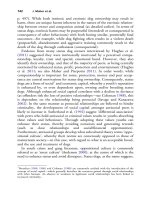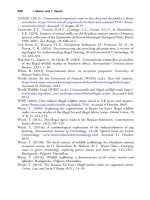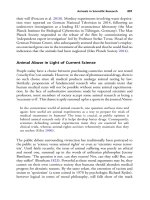The palgrave international handbook of a 122
Bạn đang xem bản rút gọn của tài liệu. Xem và tải ngay bản đầy đủ của tài liệu tại đây (38.21 KB, 1 trang )
112
A. Arluke et al.
review suggests that cases involving dogs are more likely to attract prosecutorial
attention, particularly if dead animals are found at the scene (Berry et al. 2005).
Animal hoarding frequently co-occurs with the hoarding of objects. Case
reports indicate that between 31 % and 100 % of individuals who hoard animals
also hoard inanimate possessions (Steketee et al. 2011). There are some notable
differences between object and animal hoarding. Most animal-hoarding cases
involved squalid living conditions, while only a minority of object-hoarding cases
did so (Rasmussen et al. 2014). Men and women are evenly represented in cases
of object hoarding, whereas animal hoarders are predominantly female (Steketee
and Frost 2014). Although both conditions are characterized by poor insight,
responding to animal hoarding cases is often complicated by animal hoarders’
delusional beliefs about special abilities to communicate with, understand and/or
provide care for animals (Frost and Steketee 2014).
Types of Hoarders
Animal hoarding appears to be more complex than object hoarding in the
forms it can take and the range of underlying motivations. Several useful
categories have been identified that go beyond the original basic definition
(Frost et al. 2015; Patronek 1999; Patronek et al. 2006).
The overwhelmed caregiver minimizes rather than denies animal care
problems that result from economic, social, medical or domestic changes,
such as loss of job or health, but cannot remedy these problems. Despite their
strong attachment to animals, the overwhelmed caregiver’s compromised
situation gradually leads to a deterioration of animal care.
The rescue hoarder often presents the largest and most costly problem to
law enforcement and animal control agencies. Such cases often involve large
numbers of animals, sometimes in excess of 500 cats or dogs. Virtually all of
the large-scale animal hoarding cases responded to by the ASPCA involve
‘rescue’ situations. The rescue hoarder has a missionary zeal to save all
animals. They also actively seek to acquire animals because they feel that
only they can provide adequate care and because they oppose euthanasia.
They view legitimate animal care and control agencies as the enemy and
often disparage conventional veterinary medicine and make use of unconventional and ineffective approaches to medical care—if any. Several qualities
differentiate rescue hoarders from individuals involved in legitimate animal
rescue efforts (Lockwood 2011) including the failure of rescue hoarders to
keep good records, have stable staff and dedicated veterinary services, and
their failure to refuse new intake if overcrowded.









